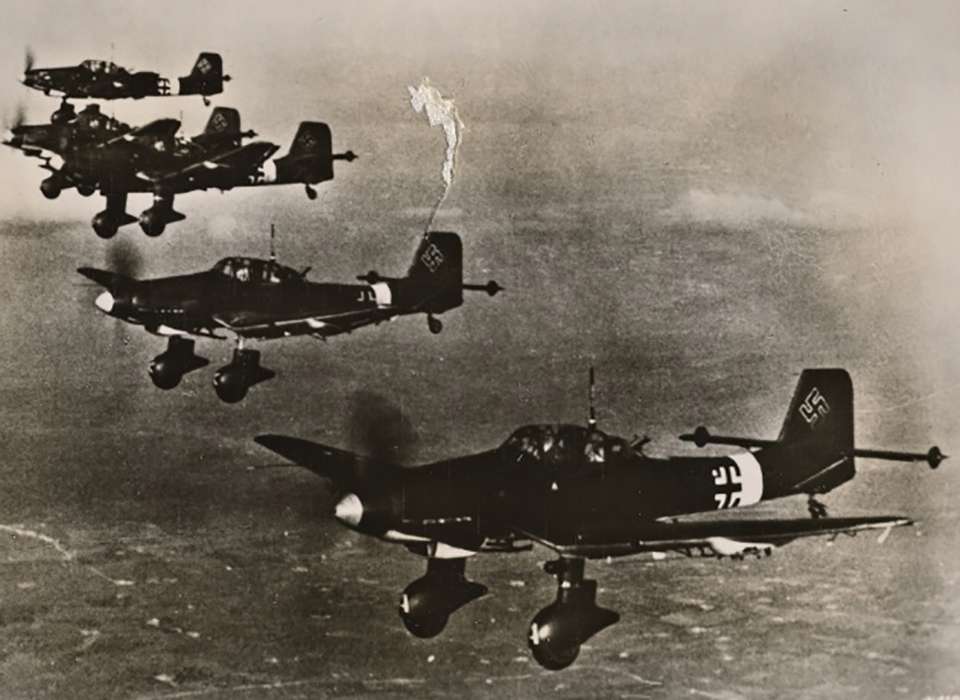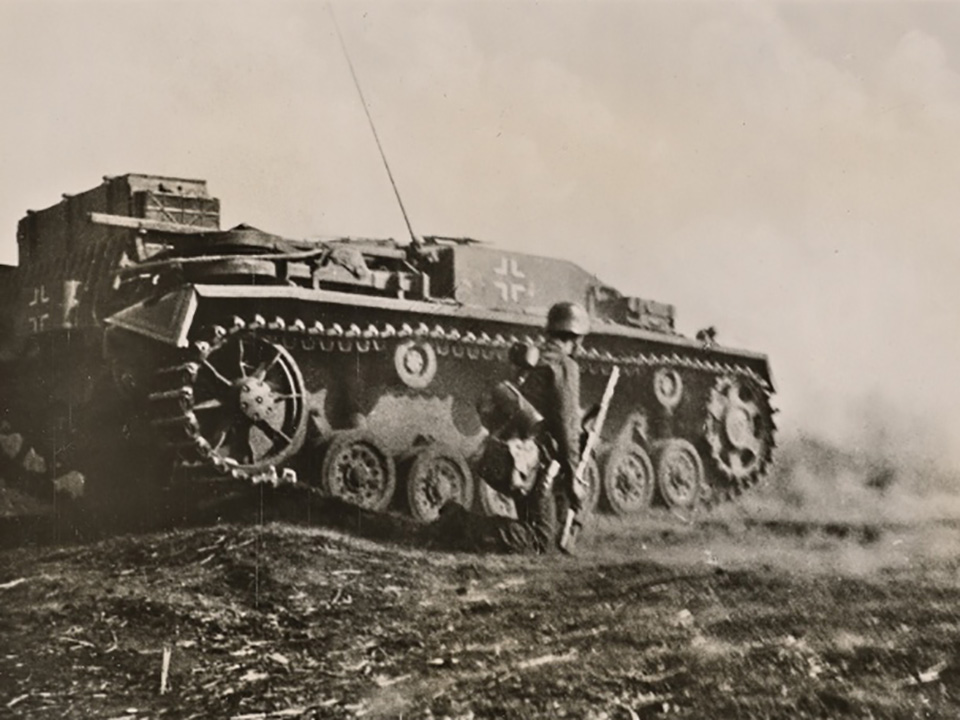Top Image: Stuka squadrons dive on the Kerch Peninsula (in eastern Crimea), attacking the arrays of supposedly-impregnable concrete defensive positions built by the Russians. The Miriam and Ira D. Wallach Division of Art, Prints and Photographs: Picture Collection, The New York Public Library. “At dawn, countless Stuka squadrons dived on the Kerch Peninsula (in eastern Crimea), attacking the arrays of supposedly-impregnable concrete defensive positions built by the Russians.” New York Public Library Digital Collections. Accessed June 11, 2021.
You have to be careful about superlatives. If you’re discussing military history, using phrases like “the greatest tank battle in history” can get you in real trouble. Human beings have been making war on one another since the origin of the species. That adds up to a lot of wars, and making overly bold claims is rarely a good idea.
Be careful about superlatives, that is, until you’re talking about Operation Barbarossa, the surprise German invasion of the Soviet Union on June 22, 1941 and the nearly four years of war that followed on what the Germans called “the Eastern Front.” With some 3.5 million German and nearly 700,000 German-allied troops (Romanians, Finns, Hungarians, Italians, Slovaks, and others) facing off against a Red Army that numbered some 5.5 million men, the opening phase of Barbarossa saw nearly 10 million human beings locked in mortal combat from the outset. And Soviet mobilization wasn’t finished by a long shot—soon there would be more than 14 million men and women called up for the war against the Germans.
You can name your metric. Divisions? The Germans employed 138 divisions, plus 36 of their allies (16 Finnish, 15 Rumanian divisions, three Italian, and two Slovakian). Toss in eight Hungarian brigades—hard to translate precisely into divisional equivalents—and you’re probably near 180 divisions. The Red Army consisted of 304 divisions at the time, spread around over the massive area of the Soviet Union (a country that sprawled across 11 time zones in that era). Examining the deployment zones, however, we can say that the USSR had 228 divisions in Barbarossa’s path. The adds up to 408 divisions. Again, it isn’t easy to find any campaign in World War II that even comes close to this size.
You want great battles? The German-Soviet war has got them: great encirclements by the Germans at Bialystok and Minsk in the opening weeks, and a mega-encirclement at Kiev in the opening months. That last one trapped four complete Soviet armies, the 5th, 37th, 26th, and 21st, and netted nearly 700,000 Soviet prisoners of war.
Dramatic swings of fortune? Once again, there is nothing like the German-Soviet War. Take the first six months. The Soviets hung on, grimly and barely, in this opening phase, as the Germans drove towards Moscow. By December 1941, the Red Army had suffered four million casualties, three million of whom were starving in German POW camps. Hopes were high, both in the German high command and at the front, that the Third Reich had won the war.
German tanks advance through the Soviet Union. The Miriam and Ira D. Wallach Division of Art, Prints and Photographs: Picture Collection, The New York Public Library. “Along with hours of co-ordinated attacks by the Air Force, tank units attacked. Assault guns rolled forward and broke the Soviet resistance.” New York Public Library Digital Collections. Accessed June 11, 2021.
That all changed at Moscow, however. Coolly amassing 17 fresh armies in front of the Soviet capital, General G. K. Zhukov launched a vast counterstrike in early December that inflicted punishing losses on the invader and that sent German forces—exhausted, freezing, understrength, and undersupplied—reeling back in some confusion. For a time, it appeared the mighty Wehrmacht might dissolve altogether under Zhukov’s hammer blows. The Germans rallied, however, partially due to an order from Hitler forbidding retreat under any circumstances. By now, the Wehrmacht had suffered one million casualties of its own on the Eastern Front. The human cost of the war in the east, one of its distinguishing features, was determined in these opening months. And in the peculiar mathematics of this bloodbath of a campaign, the Soviets could replace their losses more efficiently than the Germans could.
How about strategic significance? Here’s the clincher. Let’s be blunt: the German army lost World War II on the Eastern Front. For most of the war, 75-80 percent of the Wehrmacht had to be deployed in the East, a preponderance dictated by the sheer size of the front, and 80 percent of German war dead perished there: about four million of the five million German soldiers killed in World War II.
Americans and British sometimes take umbrage at such talk, but they shouldn’t. Roosevelt and Churchill both knew who was killing the most Germans, and their wartime policies (like Lend-Lease) were designed to help the Soviets do just that. In fact, the one strategic nightmare the Allies could never dispel was the possibility that at some point, Stalin might decide to come to terms with Hitler and drop out of the war. A separate peace would have transformed the war in Europe into a very different contest indeed, and a much more expensive proposition for the Western Powers.
So, line up those superlatives when discussing Operation Barbarossa. Whether it’s the number of divisions, the drama and the bloodshed, or the strategic significance: the Eastern Front should command the attention of any student of World War II. It really was the biggest war of all time.
And come to think of it, we actually can identify a “greatest tank battle of all time”: the big armored clash at Kursk in July 1943. I’ll give you three guesses who fought it.
Robert Citino, PhD
Robert Citino, PhD, is the former Samuel Zemurray Stone Senior Historian in the Jenny Craig Institute for the Study of War and Democracy.
Cite this article:
MLA Citation:
APA Citation:
Chicago Style Citation:






![Max Fuchs, New York City cantor, sings as Rabbi Sydney [sic] Lefkowitz, Richmond, VA, conducts the first Jewish services from Germany.](/sites/default/files/styles/max_650x650/public/2025-10/image1.jpg)



